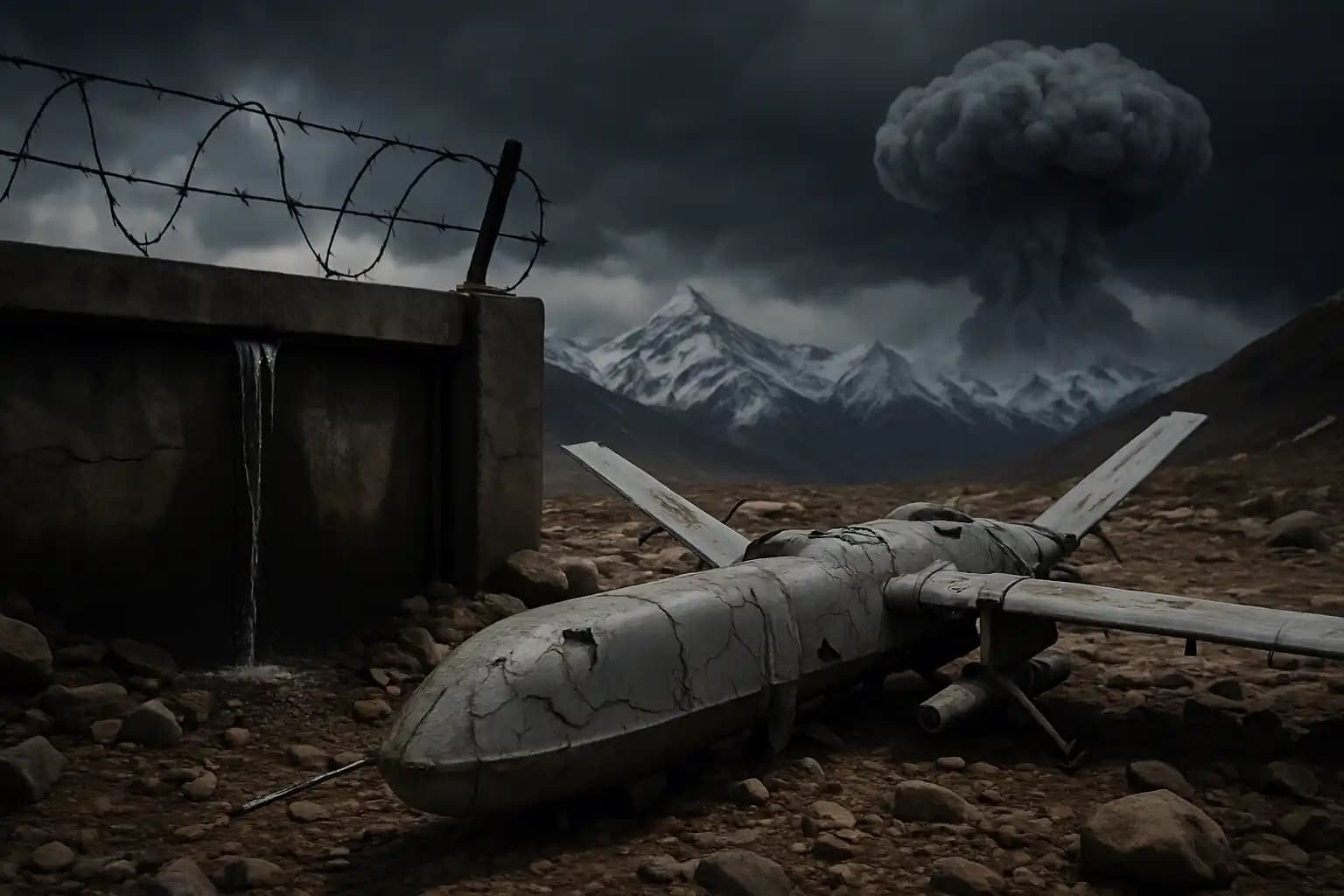1. Sparks Over a Snow Line
On a gray dawn in the Pir Panjal Range, Pakistani soldiers lifted twisted carbon fiber from a scree slope—an Indian quadcopter shot down. The official communique labeled it a spy platform that breached the Line of Control. New Delhi dismissed the charge as propaganda. But Kashmir’s mountains amplify every bullet and rumor; before the wreckage cooled, Pakistani anchors called the incident an act of war.
Within hours, Islamabad announced the suspension of certain provisions of the Indus Waters Treaty, a pact surviving wars, coups, and partition ghosts since 1960. The twin jolts—airspace violation and water leverage—electrified a region already detailed by independent conflict trackers. Analysts tallied timelines: missile flight minutes, armored division mobilization windows, and river flow measurements at border dams. The clock began ticking louder.
2. Why a Drone Matters
Drones violate sovereignty subtly: no pilot to capture, no black box to negotiate. Each downing forces leaders into a binary—ignore the incident or escalate. Kashmir has absorbed shellfire and sniper fire for decades, but unmanned eyes above the tree line feel more intimate. They suggest precision strikes, bunker mapping, and real-time artillery correction.
The LoC’s wind shear and thin air challenge most commercial models, but militaries now use temperature-hardened quadcopters that send coordinates to artillery tablets. A plastic wing becomes a strategic lens. Islamabad’s generals framed the shoot-down as proof that Indian units prepared for offensive ingress disguised as surveillance. Whether that claim holds water, public outrage moves faster than de-escalation hotlines.
3. The Water Lever Pulled
The Indus Waters Treaty grants India control of three eastern rivers and Pakistan control of western tributaries—lifelines for Pakistani farms. Suspending it weaponizes irrigation. In summer, Pakistani canals nourish cotton and wheat; choking them causes bread prices to spike in Karachi within weeks. Farmers recall 2010 floods and 2022 droughts; they fear fresh extremes.
Economists consult hydrological datasets while reviewing policy digests, mapping cascading shocks: food inflation, refugee flows, and regional grain shortages. Water security becomes food security, which turns into state security. Everyone knows the script; nobody likes the ending.
4. Nuclear Doctrine in the Rearview Mirror
India asserts “No First Use” but qualifies that pledge with threats of massive retaliation. Pakistan refuses such restraint; its posture remains “first-use if survival is at stake.” Water throttling easily meets that threshold. Strategic scholars studying declassified memos—some referenced in archival analyses—note chilling parallels with Cold War automation nightmares.
With mobile launchers on both sides, MIRV-capable Agni-V missiles, and plutonium pits ready for assembly, the distance between drone scrap and mushroom cloud shrinks uncomfortably. Open-source satellite sleuths scour imagery via remote-sensing portals for convoy patterns. A surge in transporter-erector vehicles rolling out of Pune or Kamra would raise red flags worldwide.
5. Why Satellites Can Lie
Modern sensors monitor every dam gate and cantonment road, yet they can mislead. A stray geomagnetic burst can scramble synthetic-aperture reads, causing false alerts like the mis-cue scenarios detailed in regional geophysical briefings. One garbled frame in automated warning systems could trigger pre-emptive moves neither capital intends.
Both nations upgraded early-warning networks with machine-learning analytics showcased in defense expos. AI promises split-second clarity; it also introduces split-second mistakes. Cybersecurity forums cite a mis-tagged heat plume incident that nearly escalated a 2021 artillery duel. Lessons learned? Operators now keep a human in the loop, but the reaction window continues to shrink as processor speeds increase.
6. Water Wars Meet Drone Swarms
Imagine river chokepoints guarded by autonomous quadcopters loaded with seismic sensors and micro-munitions. Commanders could deploy swarms to disable sluice gates or sabotage diversion tunnels without infantry intervention. Policy journals accessed via engineering digests warn that such tactics entice first strikes: whoever blinks first floods or starves the opponent.
The interplay between water scarcity and AI-driven arsenals echoes analysis threads archived at future-war labs. You cannot separate rivers from robots anymore.
7. Public Pulse: Street Protests and Screen Warfare
Delhi pundits urge calm while primetime panels display patriotic graphics. In Lahore, clerics preach water jihad. Hashtags trend: #AvengeTheDrone, #SaveOurIndus. Memetic warfare floods TikTok with stylized kill-cam footage—some lifted from video games and others genuine. These clips erode the firewall between spectator and combatant; every share inches the Overton window toward open conflict.
Emergency siren drills—chronicled in civil-defense field notes—now run across Punjab schools. Children learn to duck under desks not for earthquakes but for cruise-missile overflights. The generational trauma seeds itself in real time.
8. Global Stakes: Wheat Futures and Oil Routes
The subcontinent sits at shipping lanes funneling Gulf oil to Pacific factories. Insurance underwriters contemplate war-risk surcharges; Brent crude twitches. Chicago wheat futures climb 4% on rumors of irrigation sabotage. Hydro-electric projects along the Chenab power data centers handling global outsourcing workloads. A prolonged blackout could ripple into Western customer-service lines by next Monday.
Diplomats scramble. Beijing offers quiet mediation—its companies built many Pakistani dams. Washington dusts off contingency cables. The United Nations calls for restraint, referencing the original treaty text archived on Wikipedia. When the UN cites Wikipedia in emergency briefings, the library is on fire.
9. Off-Ramps and Tripwires
Can leaders de-escalate?
- Hotline Reboot: The 1991 direct line works, but only if someone answers during public holidays.
- Back-channel Hydrology: Engineers could quietly restore water flow, labeling it “maintenance.”
- Third-Party Drone Logs: Neutral observers—perhaps Swiss or Omani—verify crash telemetry, preserving egos.
- Media Chill: A 72-hour moratorium on inflammatory talk-show language could lower street heat.
Yet every option struggles against electoral cycles and nationalist pride. The longer the stalemate, the harder it becomes to close valves—literal and metaphoric.
10. Personal Preparedness on the Nuclear Frontier
Residents of Amritsar and Rawalpindi live fifteen minutes from potential strike zones. Civil-defense manuals recommend airtight rooms, iodine pills, and battery radios. If the grid fails—like the cascading outages documented at infrastructure-watch hubs—old-school shortwave could be the sole voice left.
Preppers in Mumbai and Karachi stock reverse-osmosis filters; fallout dust contaminates river intakes first. Water again—origin and endgame of the crisis.
11. A Drone, A Dam, A Doomsday Clock
A 2-kilogram UAV costs about $6,000. Its downing now jeopardizes projects worth billions and cities dense with millions. History shows world wars erupted from smaller sparks: Sarajevo’s gunshots, Pearl Harbor’s radar blip, a Gulf of Tonkin sonar ping. Kashmir just added a drone ping to that list.
The Indus will flow from the Himalayas to the Arabian Sea, heedless of treaties or tweets. Whether its banks nurture rice paddies or radiation counters depends on decisions made before the next snowmelt. Citizens must monitor water gauges and skies equally—and keep an eye on independent monitors like Unexplained.co as official statements blur.




